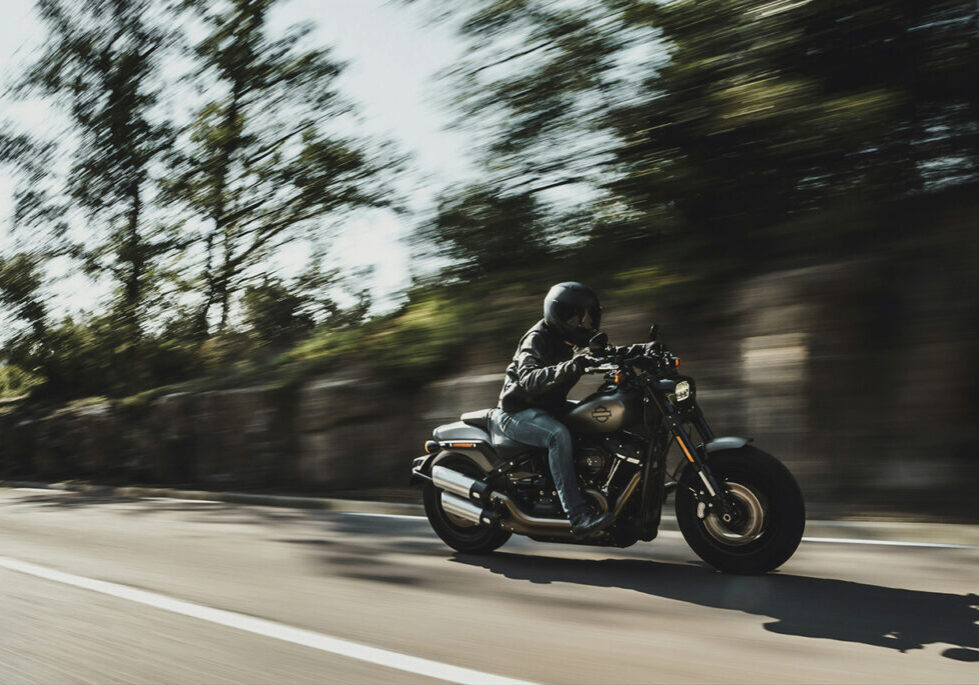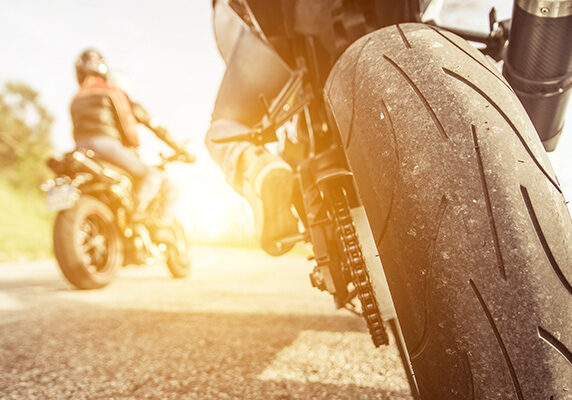An estimated 84,000 motorcyclists were injured in 2019, and more than 5,000 motorcyclists were killed the same year in the U.S. There are 8.6 million registered motorcycles in the United States, accounting for only 3.2% of the 272.4 million total registered vehicles. However, in 2017, motorcyclists accounted for 5,172 of the 37,473 total motor vehicle accidents that year, or about 13.8%. This means that motorcyclists are more than 4 times as likely to die in an accident, compared to people in other vehicles.
Riding a motorcycle is fun, but as is obvious from the above, it can be dangerous. Proper safety gear can go a long way towards protecting you while you ride. Here’s what you need to know.
Why are motorcycles less safe than cars?
In cars manufactured through the 1960s, it wasn’t unusual for drivers and passengers to be killed in minor fender benders. Steering columns were entirely unyielding, and steering wheels with steel hubs often impacted and even penetrated the driver’s chests. Meanwhile, passengers’ heads often struck the dashboard or frame of the car. Lastly, the passenger compartments were the weakest region of early cars, and thus were what gave way in the event of an accident. While vehicles back then were built like tanks, that mass did nothing to protect passengers. In the ‘80s and ‘90s, cars did get much lighter, resulting in great gas mileage. But their frames yielded easily, crushing those inside when serious accidents occurred.
Most modern cars are much heavier than cars made 30 to 40 years ago, with much of that mass dedicated to protecting passengers in case of a crash. A key component of vehicle safety is the “crumple zone,” the part of the car in front of and surrounding passengers. This may include the bumper, region of the car under the hood, and portions of the car’s frame. In the event of a crash, the crumple zone is designed to crumple easily and absorb the majority of the force, so that the passenger compartment remains intact. In addition to the crumple zone, modern vehicles have a plethora of safety features inside and out. From the most basic of safety features, such as the humble seatbelt and passenger airbags, to the newest advancements in lane-keep assist software, cars of today protect the driver and occupants better than ever before.
But motorcycles provide no such safety barriers between their passengers and the forces exerted by a crash. They do not have the benefit of crumple zones, seatbelts, airbags, or automatic driver assistance. While model styles have changed with the times, when it comes to safety, motorcycles have changed little in the last century.
Motorcycle safety requires being cautious about other drivers on the road.
Unfortunately, many drivers of cars and trucks are simply unaware of the challenges motorcyclists face. Some even forget they are sharing the road with motorcycles, neglecting to check their mirrors and general surroundings for motorcyclists. This nonchalant attitude about road safety can result in life-threatening injuries to motorcyclists, even those riding safely.
The NHTSA has stated that motorcycle awareness is one of the key means of preventing accidents and fatalities.
Motorcyclists cannot control the behavior of those around them. Thus, riding safe means riding defensively. You should also wear safety gear to help you get to your destination safely.
A properly fitted helmet goes a long way in protecting riders.
Laws regarding the wearing of motorcycle helmets vary widely across the United States. While only two states have no laws mandating the wearing of a helmet—Illinois and Iowa—another 27 states only require helmets for riders under the ages of 18, 19, or 21, depending on the state. In Florida and Indiana, riders 21 and older may waive the helmet requirement by carrying a minimum amount of medical insurance.
Only 19 states, including California, require motorcyclists to wear DOT-certified helmets. However, the level of safety afforded by such helmets varies greatly. Thus, it is quite common for riders to wear so-called “brain buckets,” which only cover the top of the head, providing no face protection. In addition, they are often little more than plastic shells, meaning they are very comfortable and lightweight, but also convey less protection than the average bicycle helmet.
Because it’s difficult for law enforcement to tell at a glance whether a rider is wearing a DOT-certified helmet, it’s not unusual for motorcyclists to wear non-certified helmets. Such riders might prioritize comfort, supposedly wanting helmets that weigh as little as possible.
The NHTSA has issued strong warnings against the purchase of such “novelty helmets,” as they strongly increase the risk of serious injury or death relative to wearing a DOT-certified helmet. Their recommend watching out for helmets which:
- Are less than 1 inch thick, and/or do not have a stiff foam liner
- Weigh less than 1 pound (helmets should weight at least 3 pounds)
- Are advertised as being the “thinnest” or “lightest” helmet available
- Have plastic buckles, instead of sturdy, riveted chin straps
- Feature decorations which extend more than one-fifth of an inch from the outer surface
For motorcycle riders who want to maximize their odds of surviving an accident, choosing the right helmet is the first step in protecting yourself when you ride.
Measure your head. You have to find the right size helmet, so you first must measure your head. Use a cloth measuring tape to find the circumference of your head. Compare your head size against helmet specifications to find the right fit for you.
Decide on the style you like best—but some styles are safer than others. There are a lot of different helmet styles to choose from. Properly designed full-face helmets are aerodynamic, comfortable, and offer good ventilation, while also offering the most protection. Other types of helmets include modular, dual sport, off-road, and half shell (some “brain buckets” fall into this last category, but some half shell helmets do offer the same protections of the aforementioned helmets). Talk to an expert if you have questions about the type of helmet most suited for your riding style.
Don’t buy online—try helmets on in-person to ensure a snug fit. There are a number of motorcycle helmets manufacturers, and each helmet will have a slightly different fit. If you can, try on multiple helmets. The ideal fit is snug—if you can shake the helmet left to right or up and down with ease, then the helmet is not a good fit, and may come off in an accident. However, if you do buy online, send it back if it does not fit properly.
Check for pain points. Head pain can occur if the helmet is too tight. Experts advise wearing the helmet for 30 minutes to 1 hour prior to your first ride. If the helmet is too tight, you will notice some pain. Any type of pain means you should look for another helmet.
No matter what helmet you choose, always make sure it is federally certified. Check the back for a DOT symbol or sticker. But, bear in mind that a helmet which meets the minimum DOT standard may still fail in accidents where a stronger helmet would provide protection. Don’t settle for the minimum level of protection.
Riders should strongly consider wearing safety gear like padded jackets, protective pants, motorcycle boots, and gloves.
While motorcycle riders don’t have access to the protection provided by cars and trucks, riders can wear motorcycle safety gear that looks good, feels comfortable, and helps protect in the event of a crash. And it’s not that hard to set yourself up with safety gear from head to toe.
Start with gloves. Armored or padded gloves are good for multiple reasons—they protect your hands in an accident, give you a good grip, and help prevent hand numbness that can occur due to prolonged exposure to vibrations. While gloves can be comfortable on hot days, you should try to wear gloves every time you fire up your bike.
Now let’s talk about motorcycle jackets. As with a helmet, you should choose the jacket most suitable for your riding style. Jackets vary in material and comfort depending on use. A jacket you might wear on the track might not work so well on the road. At a minimum, the jacket should provide padding for your elbows and shoulders. Some jackets add padding that covers the chest and spine, a good option if you are willing to spend a little more for some extra protection. When deciding on a jacket, you should also consider:
- How well ventilated it is. Riders in warmer climates will want a jacket that doesn’t trap too much heat.
- What color it is. Making yourself visible on the road is important. While a traditional black leather jacket makes for a good look, a bright yellow or green jacket is more visible.
- How it fits. Finding the right size jacket is important. If it doesn’t fit well, it may not protect you as it should. Some jackets allow you to adjust the waist or shoulder, which can help make sure it is snug.
Motorcycle jeans can be critical if involved in an accident. Motorcycle jeans strike a good balance between style and protection. As with helmets, finding the best jeans for you is all about the fit. Try some on to get a sense of what works and what does not. They should be snug around the waist, while being comfortable, as with a normal pair of jeans. Pay particular attention to jean material. Many experienced riders prefer single-layer jeans, but you can also purchase multi-layer jeans if you find that more comfortable.
Finally, shoes and boots. Inexperienced riders can make the mistake of wearing casual shoes while riding. If you prioritize safety, a standard pair of shoes won’t work. A motorcycle boot provides extra protection to your foot and ankle, while providing the flexibility necessary to operate toe or heel-toe shifters. Motorcycle shoes come in all different styles, and most manufacturers have picked up on the fact that riders want something stylish.
Riding a motorcycle is fun, but you need to equip yourself with protective gear so you can ride safely.
A motorcycle is a great way to get around and have some fun while doing it. However, you should take the steps necessary to protect yourself while riding. If you’re a beginner, visit your local motorcycle shop and talk to the experts. A good motorcycle expert can help fit you into the right size helmet, and find the jacket, jeans, gloves, and boots you need to be both comfortable and protected.



